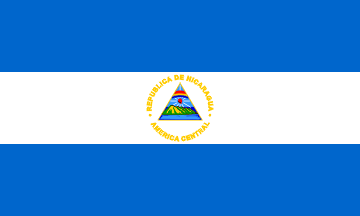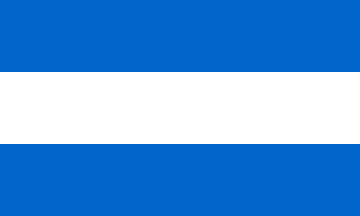
image by Željko Heimer, 3 July 2002

Last modified: 2014-06-28 by zoltán horváth
Keywords: nicaragua | america | volcano | corn islands |
Links: FOTW homepage |
search |
disclaimer and copyright |
write us |
mirrors

image by Željko Heimer, 3 July 2002
Official Name: Republic of Nicaragua
(Republica de Nicaragua)
Capital: Managua
Location: Central America
Government Type: Republic
Flag adopted: 27
August 1971 (First adopted 4 September 1908)
Coat of Arms adopted: 21 August 1823
ISO Code: NI
See also:
The blue-white-blue pattern is common to all the central
American states, being a reminder of the union from the beginning
of the 19th century. Each of the five original countries found a
way to differentiate the flag. Costa Rica put a red stripe in the
middle, Nicaragua and El Salvador their coats of arms, Honduras
five stars, and Guatemala turned the stripes vertically. All of
the states (except Guatemala) have common elements on their coat
of arms - mountains (volcanoes) with a sea on each side,
secessionist cap, spectrum, stars, and the inscription 'America
Central'. The triangle symbolizes equality. Civilians on the land
may use, also, the flag without the arms.
Željko Heimer, 24 February 1996
From <www.foonet.net>:
The National Flag: The white stripe stands for the territory of
our nation and represents the purity of our fatherland. The two
blue stripes mean our territory is bathed by two oceans.
translated by Santiago Dotor, 4 January 1999
According to [smi75],
Honduras entry (page 241) "The blue-white-blue horizontal
striped flag of the United Provinces of the Center of America,
based on the Argentine flag, was first hoisted in the
independence struggle against Spain on 4 July 1818, when the
commodore of the Argentine squadron, Louis Aury, proclaimed the
first independent Central American state on islands off the
eastern coast of Nicaragua. Aury's government lasted until
1821... ...(in 1823) when complete independence was established
the new national flag had stripes similar to, and apparently
based on, those of the first free state.."
Ned Smith, 14 May 1999
At "Nouveau Petit Larousse Illustre" (1924) -
Nicaragua: An emblem without circle of text, without rays, with a
sea in the foreground and a thin black line around the triangle
to distinguish it from the white background.
Peter Hans van den Muijzenberg, 29 October 2000
I remember that Nicaragua used silver letters in place of gold
for lesser government offices. Is this practice dropped?
Pier Paolo Lugli, 18 April 2001
I would rather say that escudo was reportedly written in black
(cf note of Album 1990). Yet all photos received from Nicaragua
(and also infos from vexillological sources) all showed escudo in
full colour (and letters in gold); this is why I dropped the note
of Album 1990.
Armand du Payrat, 18 April 2001
According to [pay00] -
National Flag (CSW/CSW 3:5) - Blue-white-blue horizontal
tricolour with the coat of arms in the middle. The coat of arms
is that inherited from the Central-american union, five
vulcanoes, two oceans, freedom hat, sun-rays, rainbow, all within
a triangle and surrounded with the name of the state.
The ratio 3:5 is found in [smi75]
[smi82] [vdv00] so also in [pay00] and probably in some other
sources. However [neu92] has the
images (this and next one) pictured as 1:2.
Flaggenbuch also explains how the lower governmnet offices
display the flag with silver inscriptions. IIRC, the FOTW
suggests that such notion is more a "vexillological
mith" then anything else.
For the national flag above I used coat of arms from Corel
Clipart. At that size the minor differences shell not be visible.
However, the coat of arms is pictured in various sources in
rather noticable (though probably unimportant, heraldically
irrelevant) differences.
Željko Heimer, 3 July 2002
The current version of the flag is adopted 27 August 1971 even
if the flag is originally that of the United Provinces of Central
America of 1821. In 1970 Evans [eva70]
writes, after discussing first the flag of Honduras
and then the flag of El Salvador:
"The national and merchant flag and ensign of Nicaragua also
places the national arms at the centre of a flag striped
horizontally, blue, white, blue, but the flag itself is
considerably longer than those of either Honduras or El
Salvador."
This is a bit curious as Honduras is 1:2 as well, but the
important part would be to distinguish it from El Salvador which
it closely resembles, especially as he pictures El Salvador and
Nicaragua with a lighter shade of blue. And indeed, where he
pictures El Slavadoe approximately 3:5, Nicaragua is pictured
approximately 1:2 (and so is Honduras).
This would suggest the ratio of the flag changed when with that
1971 adoption.
Peter Hans van den Muijzenberg, 6 July 2002
The Constitution of the Republic of Nicaragua, adopted on 19
November 1986 and published in La Gaceta, diario oficial of 9
January 1987, says:
"Title II
The State
Chapter I
Article 13. - The symbols of the nation are the National Anthem,
the Flag and the Official Seal as established by law that
determines their characteristics and use.
Sources: Spanish: Georgetown University's Political Data
Base of the Americas<www.georgetown.edu>,
Translation: P. Vagnat & J.Poels book on
Constitutions and flags [vap00].
Ivan Sache, 19 March 2003
This flag was originally that of the United Provinces of
Central America (independent 1821) from which Nicaragua succeeded
in 1838. It was re-established by a Decree of 4 September
1908, and regulated by Chapter II, Article 2 of Decree No. 1908
dated 23 August 1971 (which laid down the ratio as 3:5 and
defined the colour as 'cobalt blue'). A plain triband
without arms is in widespread use, it is officially tolerated but
has not been formally sanctioned by law.
The arms, originally adopted on 21 August 1823, are those of the
former United Provinces of Central America.
Christopher Southworth, 23 March 2003
The stripes are officially defined as "cobalt blue",
which is translated by the UK Flag Institute, BRR20 and the Album
des Pavillons as PMS 300C. No recommendaaations appear
to be given by any source for the arms.
Christopher Southworth, 4 Maech 2005
The protocol manual for the
London 2012 Olympics
(Flags and Anthems Manual
London 2012 [loc12]) provides recommendations
for national flag designs. Each
NOC
was sent an image of the flag, including the
PMS shades, for their approval by LOCOG. Once this was obtained, LOCOG produced
a 60 x 90 cm version of the flag for further approval. So, while these specs may
not be the official, government, version of each flag, they are certainly what
the NOC
believed the flag to be.
For Nicaragua: PMS 281 blue, 125 gold, 292 blue, 109 yellow, 355 green, 277 grey
and black. The vertical flag is simply the horizontal version turned 90 degrees
clockwise.
Ian Sumner, 10 October 2012

image by Željko Heimer, 3 July 2002
According to [pay00] - a plain
flag (BWB, no CoA) is used as Alternative civil ensign.
Ivan Sache, 14 January 2001
According to [pay00] -
Alternative Civil Flag (C--/--- 3:5) - The same triband without
the emblem. Again Flaggenbuch disagrees. Apart from the thing
with the ratio, there this is captioned merchant flag, (i.e. at
least ---/C--). Obviously something has changed about the
Nicaraguan flags since WWII.
Rectangular Triband is used also as Aircarft Marking.
Željko Heimer, 3 July 2002
The present form of the flag was established by a Decree of 4
September 1908, and this stipulates that the national emblem
shall appear in the centre of the flag but makes no mention of a
civil or merchant flag without arms. Such flags are, I am told,
widely used in Nicaragua, they are apparently officially
tolerated but unofficial.
Christopher Southworth, 26 Febuary 2003
Whitney Smith presents flag with coat of arms as national flag
and civil flag, and plain BWB flag as alternate civil flag.
Armand du Payrat, 27 Febuary 2003
![[Coat of arms of Nicaragua]](../images/n/ni-coa.jpg)
image from <www.foonet.net>,
located by Dov Gutterman, 2 Jaunary 1999
The national coat of arms: The five volcanoes in the
republic's coat of arms stand for the five Central American
countries, the rainbow for peace and the Phrygian cap for
freedom.
translated by Santiago Dotor, 4 January 1999
This image of the coat of
arms from a Dutch scouting encyclopedia (<www.scouting.nl>)
is slightly different. However, when compared with Smith (1975b), Smith (1980) and Crampton (1989) (which are the same
apart from black outlines of the gold letters in Crampton and
minor shade differencies) the following discrepancies can be
identified: 1) the upgoing ray is "under" the rainbow
2) relative position of the five rays touching the sea is tighter
(so they all come "within" the volcanos 3) rays are
thinner (but that might not be of importance due to smaller
images) 4) the cap is somewhat smaller (but as above again) 5)
volcanos seem to be (only slightly) higher and steeper 6) two
dots in inscription are smaller 7) the spaces between words in
the inscriptions are much smaller (a much bolder font would solve
this).
៞ljko Heimer, 17 May 1999
The coat of arms of Nicaragua was basically adopted on 21
August 1823 (as coat of arms of Central America), but it
underwent several changes, until the last version (1999) was
introduced in 1971. The coat of arms mentioned by Mr Heimer are
from a "third class source" and is completely
incorrect.
Before Nicaragua became one state (in 1825) there were two
governments: Leon and Granada.
Ralf Stelter , 13 June 1999
Here is the present coat of arms
of Nicaragua
Fred Drews , 20 November 1999
In the french flag book [pay00]
there is a different coat of arms figured for Nicaragua than on
the above as also in older books like Smith
(1980). Anybody knows when the new coat of arms was adopted?
Klaus Günther, 14 May 2002
W. Smith in his FSS 1993/66 features the new coat of arms. Yet
in a 1998 note, French naval Commander in Antilles adds to a
photo with that new coat of arms a leaflet of Nicaragua Tourism
department featuring a national flag with a simplified black and
white coat of arms.
Armand du Payrat, 15 May 2002
In the center of Nicaragua coat of arms I see there several
rays but as an "aureola" of the phrygean cap, not a
sun. In the Spanish text they say: "Bajo el arco iris, el
gorro frigio de color encarnado, esparciendo luces...",
which means that it is not the sun but the phrigean cup who
"brights". I agree that they seams like the rays of a
sun but I think that they are not. It seems that this
Phrygean cap is traced by the old engravers who designed that
"brightness" as rays of a sun, the same rays that we
can "see" when we see directly to the sun or a turn on
lamp...
Luis Havas, 16 and 19 November 2004
old.jpg)
image by Fred Drews , 20 November 1999
 _
_
image by Eugene Ipavec and Francisco Gregoric,
25 January 2010
The sash is composed of the colors of the flag plus the Coat
of Arms of Nicaragua.
Source: <www.presidencia.gob.ni>.
E.R. and Eugene Ipavec and Francisco
Gregoric, 25 January 2010